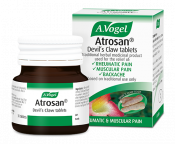A.Vogel search
When the internal search is activated, personal data such as your IP address is transmitted to our search engine Cludo. Data is thus transferred to a third country. Please click here if you want to display the internal search. You can find more information on data protection here: Privacy policy.
Lumbago (lower back pain)
Lumbago is pain in the lumbar regions of the spine and is also known as lower back pain
What is lumbago?
Lumbago, or lower back pain, is a disorder of the muscles and joints of the lower back. It is not such a popular term nowadays, despite the fact that lower back pain is a very common condition. Estimates suggest that 80% of people in the developed world will have experienced at least one bout of lumbago or lower back pain in their lives.
The word lumbago refers to pain in the lumbar region of the spine – the lowest third and hence, the use of the terms ‘lower back pain’ and ‘low back pain’.
Sometimes, people with lumbago also say they have ‘back pain’. Although the word ‘back’ can describe the area of the body running the length of the spine from shoulders to the buttocks, the phrase ‘back pain’ usually refers to pain in the lower back rather than pain in upper parts of the spine, such as neck pain.
Causes of lumbago (lower back pain)
The frustrating thing for people who suffer from lumbago is that it is frequently impossible to identify the cause of their lower back pain. The spine is a complex structure with a rich nerve supply, and the messages being fed back to the brain are not always very specific about where the pain is primarily located or how much damage has been done.
Lower back pain can be triggered by a sudden movement, a fall, or lifting something which is too heavy. These events are usually associated with a sprain or strain of the muscles and joints of the back, triggering an episode of lumbago. Often, these acute episodes of lower back pain clear up within a couple of weeks, but some people suffer low back pain for considerable periods of time and often, episodes of pain in the lower back can be recurrent.
Although lumbago is common, only 25% of cases of lower back pain can be firmly identified as being due to specific problems. These include:
- A slipped disc
- Osteoarthritis
- Osteoporosis
Very rarely, pain in the lower back can be due to life-threatening or serious conditions such as a bone tumour or nerve tumour in the spine, or a fracture of the spine.
What symptoms to expect
The experience of lumbago can often be different from one person to another. A pulled or bruised muscle in the lower part of the back may, in some cases, generate more pain than an injured disc which is considered to be a more serious problem.
The whole of the lower back can be painful, with muscle spasms in the lumbar area. Pain may radiate from the lower back into the buttocks, groin or back of the thigh(s). This pain may sometimes be accompanied by tingling or numbness.
Muscle spasms will give rise to stiffness and limitation of movement in the lower back, making bending forward, backwards or any other direction difficult. When this happens, it is common for people to compensate by holding themselves differently – this may cause further muscular problems in the lower back as well as other areas of the body as they are ‘thrown out of balance’.
If you experience numbness in the whole of your lower back or in your legs, if you lose control of your bladder or bowel, or if your legs feel weak, seek medical attention as soon as possible.
Activities for lower back pain
If you have a tendency to suffer from lower back pain, it is, in general, very beneficial to keep active. Back pain exercises may be advised by a physiotherapist, osteopath or chiropractor to help low back pain. Regular gentle exercise such as walking or swimming can also help prevent the occurrence of lumbago.
In addition, specific moderate exercise intended to strengthen the muscles in the lower back and stomach may be helpful in reducing the likelihood of further episodes of low back pain, as weak muscles are more prone to damage. Some of these exercises may be found in the book ‘Life Without Arthritis’ by Jan de Vries.
 Looking for a solution to to help relieve symptoms such as muscle and joint pain, backache, rheumatic pain and lumbago?
Looking for a solution to to help relieve symptoms such as muscle and joint pain, backache, rheumatic pain and lumbago?
Buy now from your local store.
“I have used these for several years and would not wish to be without them.”![]()
To find local independent stores in your area that sell Atrosan Devil’s Claw tablets, simply type your postcode below.

UK 5-day pollen forecast
Stay up to date with the latest pollen information by finding your local pollen forecast from over 30,000 locations across the UK.





